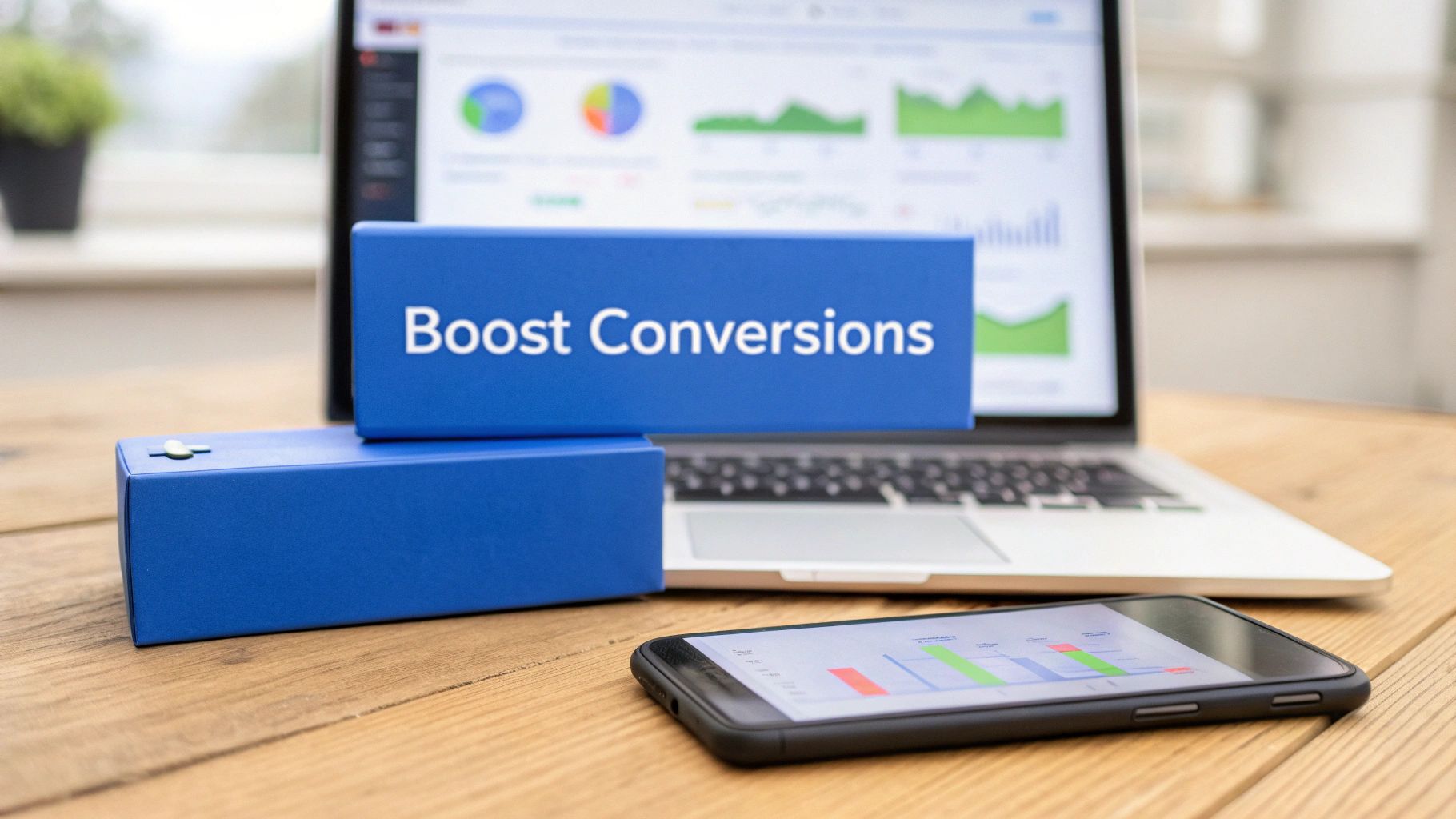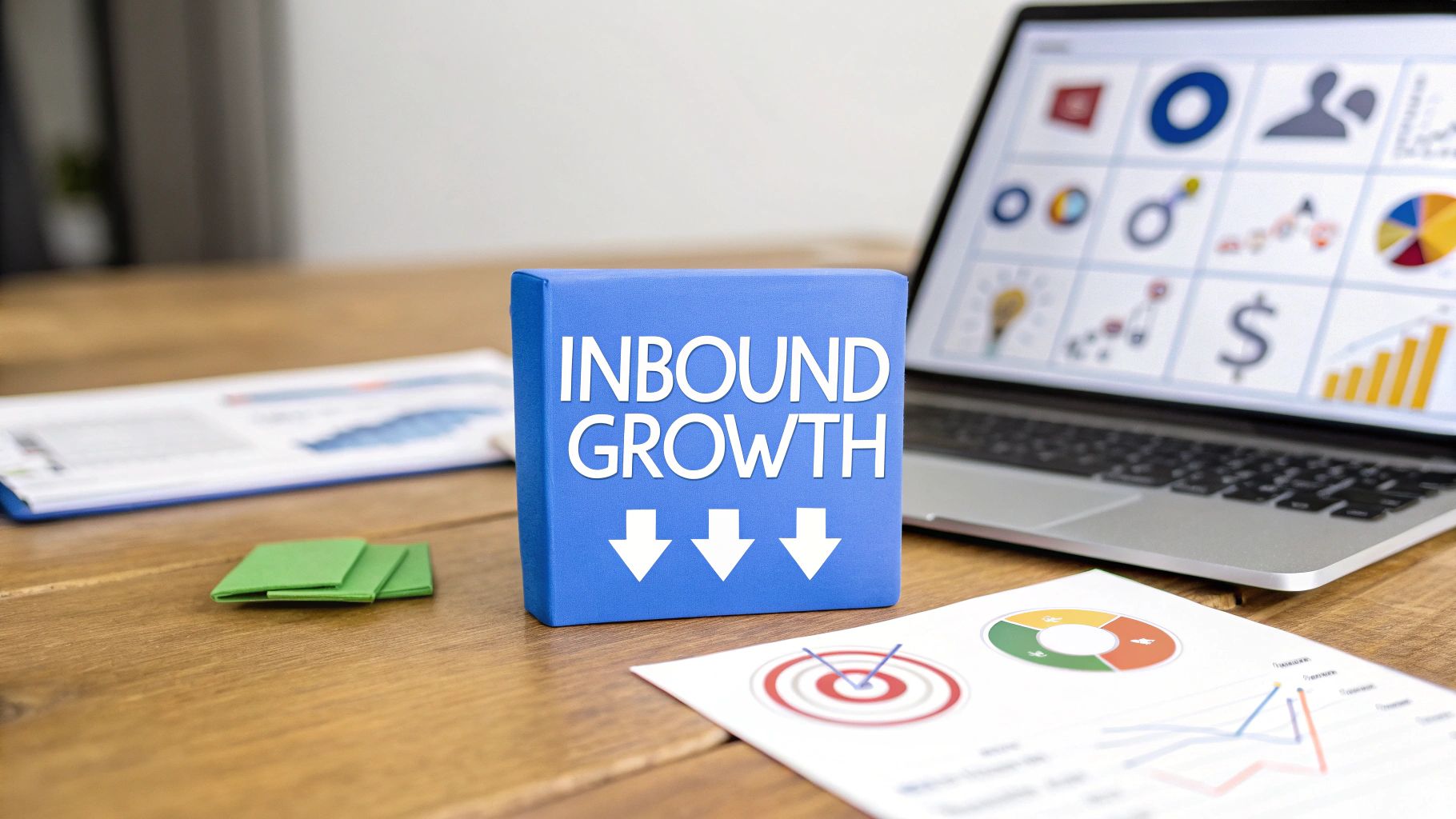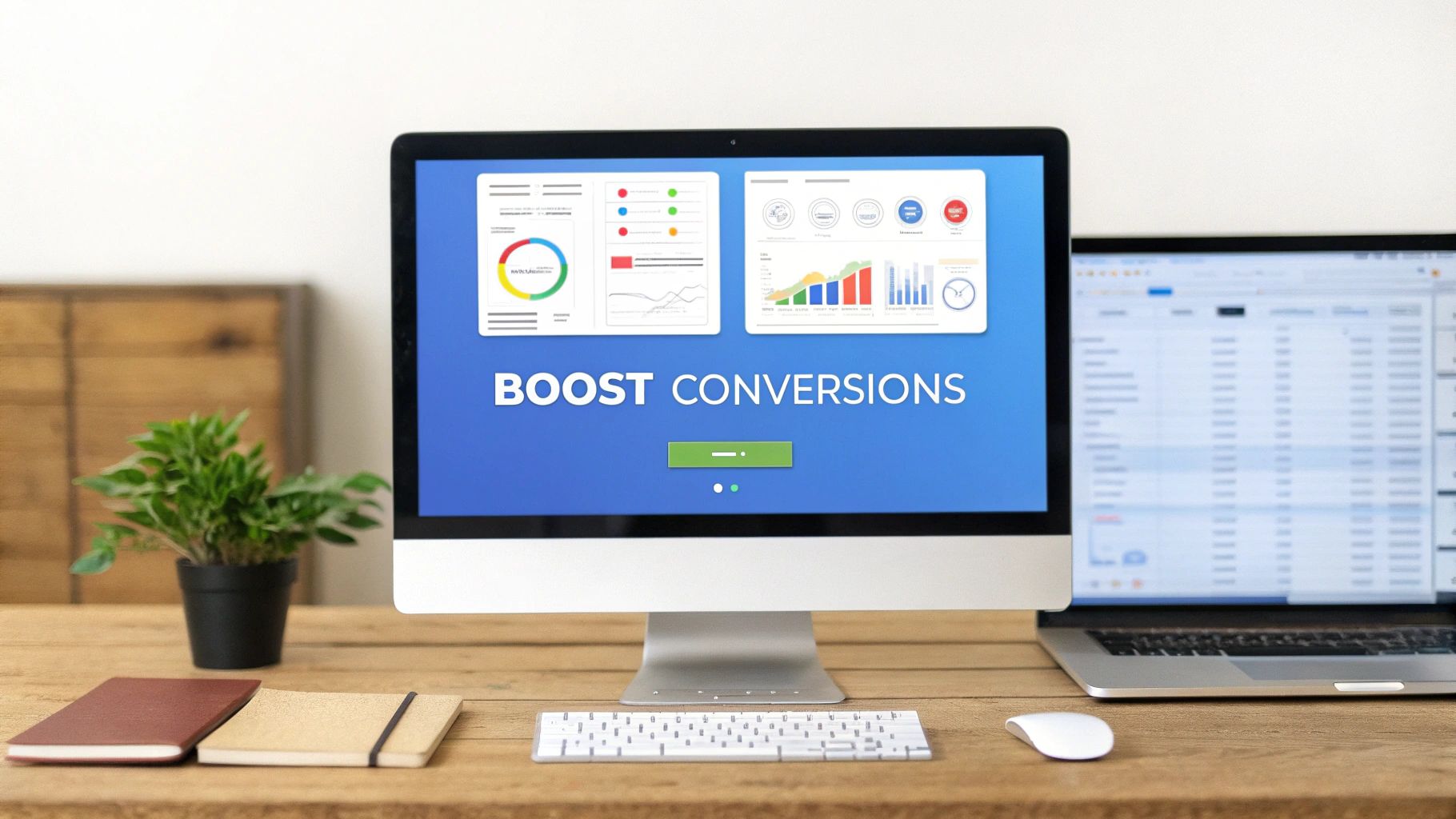Summary
Meta description: Discover the best conversion rate optimization software to boost sales and ROI. This guide covers key features, real-world examples, and how to choose the right tools.
Think of conversion rate optimization (CRO) software as your secret weapon for turning more website visitors into actual customers. It’s a suite of tools designed to help you figure out what your users are doing, test changes based on that behavior, and ultimately, boost your revenue—all without having to pour more money into your ad budget.
Ready to find out how? Let's dive in.
Why is CRO Software So Important Now?
Imagine your website is a physical store. You're getting plenty of people walking through the door, but for some reason, very few are making it to the checkout counter. Something is stopping them. CRO software is like having an expert store manager who can track where shoppers go, see what they look at, and then rearrange the displays to create a smoother path to purchase.

With the cost of acquiring new customers climbing higher every year, getting more value out of the traffic you already have is no longer just a good idea—it’s essential for survival. This is where CRO tools come in, letting you run A/B tests, analyze heatmaps, and roll out improvements backed by real, hard data.
Here’s what that looks like in practice:
- You get data-driven insights that show you exactly where people are getting stuck.
- You can run scientific tests on headlines, images, and calls-to-action to see what works best.
- You get a much better return on investment without increasing your ad spend.
- You create a better user experience that keeps people coming back.
The proof is in the numbers. The CRO software market has exploded from $3.01 billion in 2019 and is on track to hit $5.07 billion by 2025. You can dig into more details about this trend on SuperAGI.
But here’s the thing: adopting CRO software isn't just about running a few tests here and there. It’s about building a culture of continuous improvement. When your team starts treating every idea as a hypothesis to be tested, you learn what truly resonates with your customers. This mindset shift encourages curiosity, data-backed decisions, and rapid innovation.
How to Identify User Behavior Patterns
So, how does it all work? CRO platforms collect data like heatmaps (which show where people click), session recordings (which let you watch a user’s journey), and click data to reveal what grabs attention and what gets ignored. This information is pure gold, helping you prioritize the changes that will deliver the biggest wins.
“Testing real pages and measuring the impact in real time is the foundation of effective optimization.”
These tests take the guesswork out of the equation. Instead of debating what you think will work, you can invest in changes you know will move the needle.
To make it even clearer, let's break down what these tools actually do for you and why it matters for your bottom line.
Core Functions of CRO Software at a Glance
At the end of the day, each function is designed to give you a clearer picture of your customer so you can build a better experience for them.
What are the Key Drivers of CRO Adoption?
Let’s be honest—the digital world is getting more crowded and expensive. Rising ad costs and fierce competition are forcing marketers to be smarter with their resources and squeeze every ounce of value from their existing traffic. At the same time, users have come to expect flawless, intuitive online experiences. Optimization is no longer optional.
Here are the big drivers:
- Rising ad costs mean you need to convert more of the clicks you're already paying for.
- Increased competition demands that your website performs better than everyone else's.
- The explosion of mobile and voice interfaces requires constant testing of different user journeys.
- The rise of AI allows for smarter predictions about what changes will drive future conversions.
When budgets are tight, the ROI from a solid CRO program is often the quickest path to meaningful growth. That's why smart digital teams see investing in the right software not as a cost, but as a strategic imperative.
How to Make Data-Driven Decisions
The best CRO software doesn't live in a silo. It connects with your analytics platforms, CRM, and other marketing tools to give you a complete, unified view of the customer journey. This allows your team to pull reports, share insights, and make sure every test aligns with your bigger business goals. It's time to stop guessing and start optimizing.
Decoding the Must-Have Features in CRO Platforms
When you start looking into conversion rate optimization software, you’re really getting familiar with the tools that take the guesswork out of improving your website. These platforms are much more than just fancy dashboards; they're engines built to help you understand what your users are actually doing—and how to make their experience better.
Let's break down the core features you’ll run into.
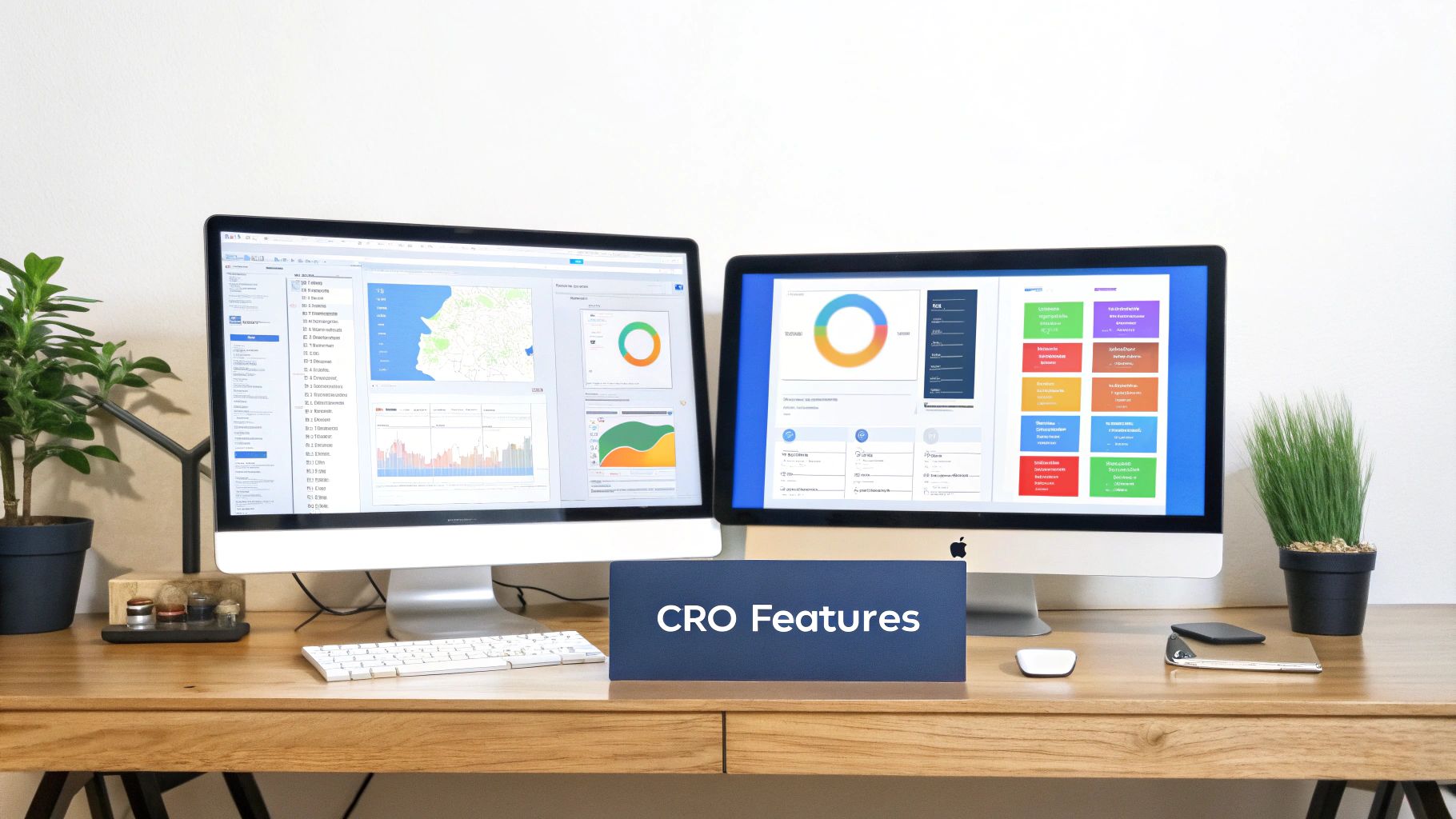
This image shows a classic A/B test in action. It’s simple: you split your traffic between two versions of a page to see which one gets more people to convert. By pitting 'Variation A' against 'Variation B' and measuring the results, you get definitive proof of what works and what doesn't.
A/B Testing and Multivariate Testing Features
The absolute cornerstone of any CRO platform is its ability to test your ideas.
A/B testing, often called split testing, is the most direct way to do this. You cook up two versions of a webpage (let’s call them A and B) that are identical except for one key change. Maybe it’s a new headline, or maybe you change the color of your call-to-action button. The software splits your traffic between the two, and the version that drives more conversions is your winner. Simple.
Multivariate testing is the next level up. Instead of just testing one change at a time, you can test a whole bunch of changes at once. Imagine testing two different headlines, three different images, and two button styles simultaneously to find the single best combination. This is a game-changer for high-traffic pages where you want to optimize several things at once.
It’s no surprise that the global CRO software market, valued at $1.23 billion in 2023, is expected to explode to $4.15 billion by 2032. The A/B testing segment is a massive part of that, proving just how essential this feature is for any serious business. You can check out more details on this growth over at DataIntelo.com.
Visualizing User Behavior with Heatmaps
Ever wish you could just see where your visitors are clicking on a page? That's exactly what heatmaps do. They overlay a visual map on your website, using colors—usually from hot to cold—to show you where all the action is happening.
A heatmap can instantly tell you that users are furiously clicking on an image that isn't actually a link, or that they're completely ignoring your main call-to-action button. The insight is immediate and incredibly powerful.
Think about an e-commerce site. They might use a heatmap and discover that almost nobody scrolls down far enough to see their shipping policy—a huge source of pre-purchase anxiety. Armed with that knowledge, they can move that info higher up the page, tackle a major customer pain point, and hopefully watch their cart abandonment rate drop. Problems like these become obvious when you have the right landing page optimization tools at your disposal.
Gaining Deeper Insights with Session Recordings
While heatmaps give you the big picture of what users are doing, session recordings tell you the story of why an individual user might be running into trouble. These are basically anonymized video replays of a real person's journey on your site. You get to watch their mouse movements, see where they hesitate, and pinpoint exactly where they get stuck or frustrated.
Here’s a real-world example: A SaaS company notices a ton of people are dropping off during the sign-up process. They watch a few session recordings and see that users are "rage-clicking" a button that's broken on a specific web browser. Without that recording, the bug could have slipped through the cracks for weeks, costing them a fortune in lost leads.
Session recordings transform abstract data points into real human stories you can act on.
The Real Business Impact of Using CRO Software
Let's get one thing straight: the ultimate goal of conversion rate optimization software isn't just to nudge a percentage up on a dashboard. It’s about building a healthier, more profitable business from the ground up. These tools give you a direct line into your customer's head, showing you friction points and opportunities you never knew existed.

When you methodically improve the user experience, you don't just get a short-term sales bump—you build genuine brand loyalty. A smooth journey from discovery to checkout makes customers feel understood and valued. That's what brings them back, and it's far more sustainable than constantly chasing new leads.
Driving a Stronger Return on Investment
Optimizing conversions from your existing traffic is way more cost-effective than pouring money into ads to get new visitors. Think about it: you've already paid to get those people to your site. CRO software simply helps you make the most of that initial investment.
The numbers don't lie. While the average conversion rate across most industries hovers around 2.35%, the top 25% of companies are hitting 5.31% or higher. Businesses that get serious about CRO see an average return on investment (ROI) of 223%. That’s a powerful testament to how effective these strategies are.
This impact reaches beyond just sales. By figuring out what truly drives action, you can sharpen performance across every touchpoint. For a concrete example, check out this guide to a lead generation chatbot to see how software can turn passive visitors into active leads.
Gaining Deeper Customer Understanding
Every A/B test, heatmap, and session recording paints a clearer picture of who your customers are and what they really want. This kind of insight is priceless. It informs everything from product development to your core marketing message. You stop making assumptions and start making data-backed decisions.
CRO isn't just about tweaking numbers; it's about improving the customer experience. When you focus on helping users achieve their goals, higher conversion rates are the natural result.
This deep understanding helps you fine-tune your website's performance and track progress that actually matters. If you want to learn more about what to measure, check out our guide on the most important KPIs for a website.
Ultimately, conversion rate optimization software empowers you to:
- Slash customer acquisition costs: Get more value from the traffic you already have.
- Boost customer lifetime value: A better experience means more repeat business and loyalty.
- Improve scalability: As you grow, you can confidently scale what's already proven to work.
Putting money into CRO is an investment in understanding your audience. And that always pays dividends.
Putting CRO Software to Work in the Real World
Theory is great, but seeing results is what really counts. Conversion rate optimization software isn't just a box of abstract data; it's a practical toolkit for driving real, tangible business growth. Let's walk through a few scenarios where these tools become absolute game-changers, turning murky user behavior into clear, profitable outcomes.
Slashing Cart Abandonment for E-Commerce
Picture an online store bleeding sales from cart abandonment. Their analytics show people adding items to their cart, only to disappear right before paying. The team has a hunch it’s the shipping costs, but a hunch isn’t a strategy. They need proof.
This is where A/B testing software comes in. They set up a simple experiment with two versions of their checkout page. Version A is the original design, but Version B features a big, hard-to-miss banner at the top clarifying their free shipping policy.
After running the test for just two weeks, the data tells a clear story: Version B slashed cart abandonment by 18%. That one data-backed tweak translates directly into a serious bump in daily sales.
Improving SaaS User Onboarding
Now, let's look at a SaaS company. They're struggling to get free trial users to pull out their credit cards and become paying customers. They see a massive drop-off right after sign-up, which screams "confusing onboarding experience." The problem is, they have no idea why people are bailing.
They deploy session recording tools to get some answers. By watching anonymized screen recordings of new users, they quickly spot a pattern. Dozens of users are hitting a wall at the exact same step: the initial project setup. The interface is clunky, and people are just giving up in frustration.
The "why" behind your numbers is often more valuable than the numbers themselves. Session recordings turn a confusing metric into an actionable story.
Armed with this visual proof, the design team gets to work streamlining that specific step. The result? A 25% jump in trial-to-paid conversions the very next month. By finding and fixing a single point of friction, they unlocked a significant new revenue stream. This is a perfect example of applying the conversion rate optimization best practices that separate thriving companies from the rest.
Generating More Qualified Leads for Local Services
Finally, let's consider a local plumbing business. Their website gets a decent amount of traffic, but the contact form is collecting dust—very few real leads are coming through. They figure the form is too long or just poorly designed, but they're not sure where to start.
They decide to install heatmap software on their contact page. The visual data is immediate and illuminating, revealing two glaring issues:
- The heatmaps show that most users never even scroll far enough to see the "Submit" button.
- The "Phone Number" field is lit up with "rage clicks"—a clear sign of user frustration.
Guided by these insights, they redesign the page. They chop the form down, make the phone number field optional, and move the "Submit" button into a much more prominent spot. This simple redesign, informed by how people actually used the page, delivered a 40% increase in qualified leads in a matter of weeks.
How to Choose the Right CRO Software for Your Team
Picking the right conversion rate optimization software can feel like you're navigating a maze. There are countless options out there, each promising the moon, but the real goal isn't finding the "best" tool—it's about finding the best tool for you.
The key is to cut through the noise with a clear framework. A little structure goes a long way in helping you match a platform's capabilities to your team's day-to-day reality, ensuring you pick a tool that gets used instead of one that just gathers digital dust.
Define Your Core Requirements
Before you even glance at a feature list, you need to be crystal clear on what you’re trying to fix. Are you an e-commerce store fighting to reduce cart abandonment? Or a SaaS company trying to smooth out user onboarding? Your primary goal will immediately tell you which features are must-haves versus nice-to-haves.
Next, think about who's actually going to be using the software. Is your team stacked with seasoned data analysts who can get their hands dirty, or do you need a simple, no-code visual editor that marketers can run with, no developer help needed? An honest look at your team’s technical skills is crucial for adoption.
Consider Budget and Scalability
Budget is obviously a big one, but don't just stop at the monthly subscription fee. You need to consider the total cost of ownership, which includes any sneaky training or implementation fees. Some platforms lure you in with low entry-level pricing that skyrockets as your traffic grows, so make sure you understand exactly how their pricing model works.
Scalability is just as critical. The tool you choose today needs to support your growth tomorrow. Does it offer advanced features you can grow into? A platform that seems perfect for a small startup might feel incredibly restrictive once you start scaling your optimization efforts.
This decision tree gives you a simple path for narrowing down your options based on these core factors.
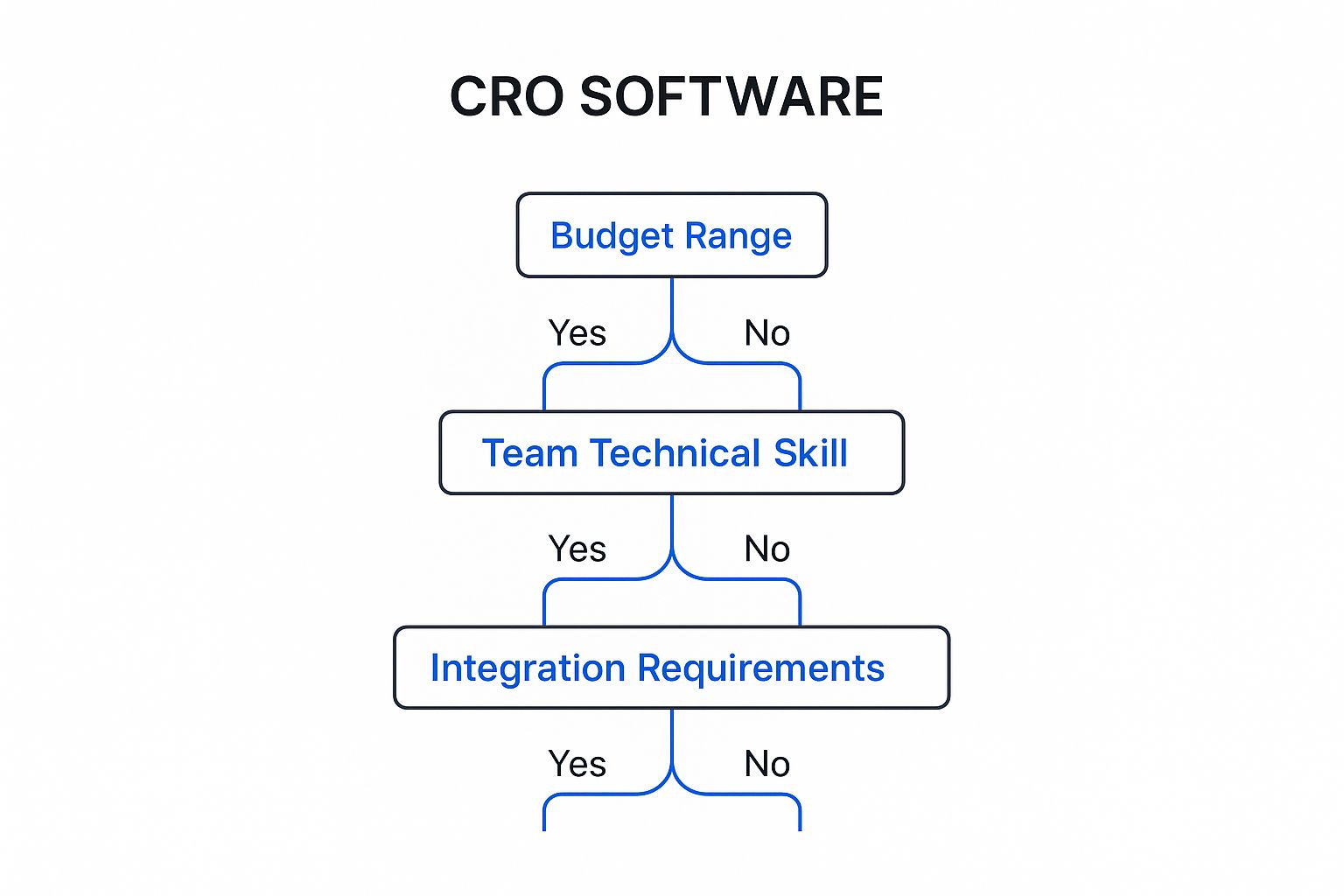
As the infographic shows, your budget, team skills, and existing tech stack are the real pillars of your decision. Get those right, and you'll quickly find yourself with a shortlist of platforms that actually make sense.
Evaluate Integrations and Support
No software lives in a bubble. Your CRO platform has to play nice with the tools you already rely on, like Google Analytics, your CRM, or your email marketing platform. Bad integrations lead to data silos and a ton of manual work, completely defeating the purpose of an efficient workflow.
Finally, never, ever overlook customer support. When you’re in the middle of a critical A/B test and something goes wrong, you'll want fast, knowledgeable support to get you back on track. Dig into reviews to see what real customers are saying about their support experiences. A great way to sort through the countless options and user reviews is by consulting resources like a guide to the Capterra software marketplace, which offers a structured way to compare platforms using genuine user feedback.
To help you stay organized during your evaluation, we've put together a simple checklist of the key factors to consider when comparing different CRO software options.
Key Factors for Choosing CRO Software
This table serves as a practical guide to keep your priorities straight. By systematically checking each potential tool against these factors, you can move past the flashy marketing and focus on what truly matters for your business. This approach will lead you to a solution that not only meets your current needs but also supports your long-term growth.
Common Questions About CRO Software Answered
Diving into the world of conversion rate optimization can bring up a lot of questions. That's completely normal. Before you invest your time and money into a new approach, you want to be sure it's the right move. To give you that confidence, we've tackled some of the most common questions we hear all the time.
How Long Does It Take to See Results?
This is always the first question on everyone's mind, and the honest answer is: it really depends on your website traffic.
A busy e-commerce site might get statistically significant results from an A/B test in just a few days. On the other hand, a B2B site with less traffic might need to let the same experiment run for several weeks to gather enough data.
Think of CRO as a long-term game plan for continuous improvement, not a magic bullet. If you want to see potential wins sooner, start by testing your highest-impact pages—think your checkout flow or main product landing pages. Patience is your best friend here.
Is This Software a Nightmare to Set Up?
Not anymore. The old idea that you need a team of developers just to get started is completely outdated. Most modern conversion rate optimization software is built specifically for marketers.
Getting it up and running usually just means adding a single snippet of JavaScript code to your website. If you’ve ever installed Google Analytics, it’s a very similar process.
Many of the top platforms even have intuitive, drag-and-drop visual editors. These tools let you build and launch pretty sophisticated tests and personalization campaigns without ever looking at a line of code. Sure, a really complex experiment might still need a developer's touch, but getting started is easier than ever.
Can I Use CRO Software with Google Analytics?
Absolutely. In fact, you should. Using them together is like having a superpower for understanding your website's performance. They complete each other's stories.
Google Analytics is brilliant at telling you what is happening on your site (like, "This page has a 75% bounce rate"). CRO software helps you figure out why it's happening (for example, a heatmap shows users are rage-clicking a broken button) and gives you the tools to test a fix.
Here’s how they team up:
- Google Analytics flags problem areas with hard data.
- CRO software gives you the "why" with qualitative insights like session recordings, helping you form a solid hypothesis.
- A/B testing tools then let you prove that hypothesis with a real experiment.
Most top-tier CRO platforms integrate directly with Google Analytics, letting you sync data to create one unified, powerful system for insights. This combination turns raw numbers into real business growth by connecting what users do with outcomes you can measure.
Ready to turn more of your ad clicks into customers? LanderMagic offers dynamic, AI-powered landing pages designed to maximize your conversions and lower your acquisition costs. See how our platform can transform your post-click experience. Get started for free with LanderMagic.



